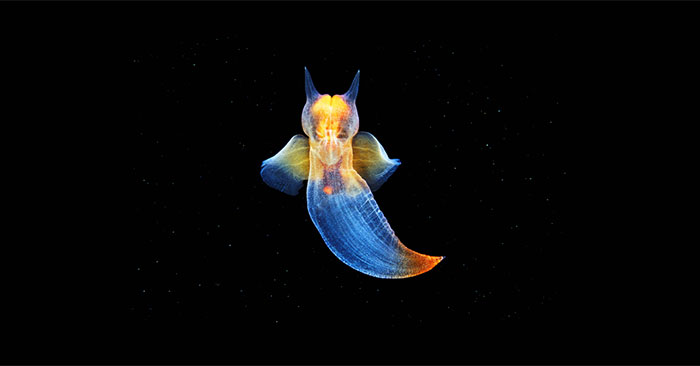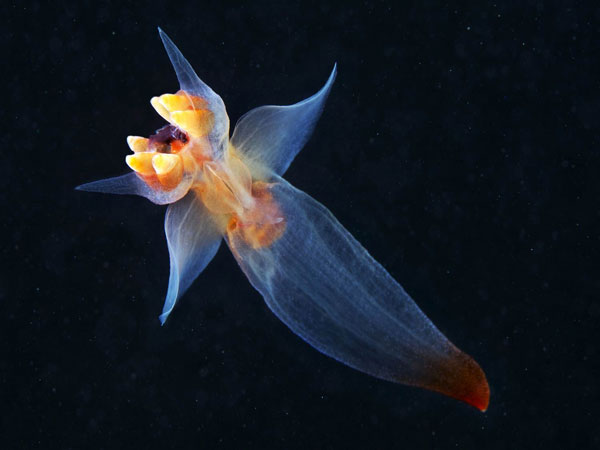Sea Angel - a dangerous predator with a surreal beauty that seems to only exist in fairy tales
The sea angel is a beautiful creature under the ocean but a fearsome predator. Here are some interesting facts about the sea angel .
Sea angels are tiny, nearly transparent sea slugs with wing-like appendages that live in oceans around the world.
They are quite small in size, the largest being only about 7cm long, while many are under 2cm. Without their 'wings' they look very much like common land slugs.

Despite their cute appearance, they are actually quite dangerous predators. Their favorite food is other snails including sea butterflies, their close relatives that live in snail shells.
The sea angel can glide across the water at a speed of 10cm/s, almost as fast as a goldfish. This speed is enough to help this strange creature easily surpass its prey. Not only relying on speed, the sea angel also has another unique way of hunting, the opposite of chasing is waiting. It makes its prey do all the work and becomes the laziest predator in the world.

Normally, sea butterflies use the mucus secreted from their feet to catch plankton. Then, when it is time to eat, they eat the prey attached to the mucus. The concept and function of the sea butterfly's mucus is similar to that of a spider web. But when the sea butterfly encounters the prey of the sea angel in the mucus, the situation turns around and the sea angel becomes the hunter.
In most animals, hunting is very energy-intensive, but sea angels use passive hunting techniques that save energy while still getting food.
The Difference Between Sea Angels and Sea Butterflies
Sea angels and sea butterflies are both pteropods—sea snails and sea slugs that swim. Sea angels, or Gymnosomata (meaning 'naked bodies'), do not have shells. Sea butterflies (Thecosomata) are usually smaller and have shells.
What species do sea angels eat?
Sea angels are an important food source for a number of animals including jellyfish, ctenophores, fish, baleen whales and birds. In the murky waters of the deep sea, the transparent bodies of sea angels help them hide from predators.
How do sea angels reproduce?
Clione are hermaphrodites, meaning they have both male and female reproductive organs. During mating, individuals will come together for several hours and fertilize each other. After fertilization, the sea angel will lay eggs in a free-floating ball.
You should read it
- Close-up of fish walking on the seabed surprised many people
- Hate to make a strange snake lizard-like creature
- Coral reefs are threatened by ocean acidification, which can disintegrate before 2100
- Disney netbook for children
- The strange creature re-grows its head, turning its prey into water
- Listed 10 largest species of creatures in the ocean
- 3D printing technology - 'angel' of unhappy lives
- 10 photos showing how small people are in the ocean
May be interested
- Fairy Tail: Top 4 main guilds that stand out in the story
 in fairy tail, the guild itself consists of approved wizard guilds and are registered at the magic council. all guilds will carry out their lawful duties and be subject to the rules set by the council.
in fairy tail, the guild itself consists of approved wizard guilds and are registered at the magic council. all guilds will carry out their lawful duties and be subject to the rules set by the council. - Predator Triton 500 - the most sought after gaming laptop in 2020
 the predator triton 500 features a new processor and graphics card, a 3-fan cooling system including aeroblade 3d 4th generation fans, and a super-fast 3s1 warranty, ultrathin gaming laptops are being hunted by hardcore gamers this summer.
the predator triton 500 features a new processor and graphics card, a 3-fan cooling system including aeroblade 3d 4th generation fans, and a super-fast 3s1 warranty, ultrathin gaming laptops are being hunted by hardcore gamers this summer. - Instructions for entering the latest Guardian Tales codes and codes
 guardian tales is an action role-playing game with pixel graphics style. the game tells the story of guardian knight, a newly recruited member of the guardians, the royal bodyguard of the kingdom of kanterbury.
guardian tales is an action role-playing game with pixel graphics style. the game tells the story of guardian knight, a newly recruited member of the guardians, the royal bodyguard of the kingdom of kanterbury. - Acer launched the Predator Triton 500 with the first new CPU and RTX SUPER card in Vietnam
 acer vietnam officially introduces the latest upgrade of the predator triton 500 gaming laptop in its predator product line. triton 500 is a popular gaming laptop with an aluminum unibody design, ultra-thin, ultra-light, using the latest processors and graphics cards from intel and nvidia first in vietnam, as well as the system.
acer vietnam officially introduces the latest upgrade of the predator triton 500 gaming laptop in its predator product line. triton 500 is a popular gaming laptop with an aluminum unibody design, ultra-thin, ultra-light, using the latest processors and graphics cards from intel and nvidia first in vietnam, as well as the system. - Acer launched the Predator Helio Neo 14 laptop
 recently acer launched a 14-inch laptop in the predator helio series, called acer predator helio neo 14. the device is equipped with intel core ultra cpu chip and gpu up to rtx 4070, priced from 44.9 million vnd.
recently acer launched a 14-inch laptop in the predator helio series, called acer predator helio neo 14. the device is equipped with intel core ultra cpu chip and gpu up to rtx 4070, priced from 44.9 million vnd. - Despite the usual laws of physics, these 10 surreal locations are causing headaches for scientists
 in the world there are different and strange places that exist but go against the laws of normal physics, as if they originated from a different planet such as a hundred-degree river, wells of petrifying water. body, radioactive lake, green lava volcano, ...
in the world there are different and strange places that exist but go against the laws of normal physics, as if they originated from a different planet such as a hundred-degree river, wells of petrifying water. body, radioactive lake, green lava volcano, ... - 7 beautiful autumn paths as in the fairy world
 coming here, you will admire the brilliant, splendid trees like in the magic fairy picture.
coming here, you will admire the brilliant, splendid trees like in the magic fairy picture. - Discover beautiful white elk from head to toe like stepping out from fairy tales
 photographer hans nilsson was fortunate to record the image of a great white moose from head to toe, even his gauze wrapped in white velvet when it was wandering in the värmland region of southwest sweden.
photographer hans nilsson was fortunate to record the image of a great white moose from head to toe, even his gauze wrapped in white velvet when it was wandering in the värmland region of southwest sweden. - Strange beauty of lava pillow under the Atlantic Ocean
 dr. isobel yeo and researchers from helmholtz geomar research center in kiel city, germany have traveled to northern iceland to record the surreal beauty of lava pillow at eggvin bank volcano in the atlantic ocean.
dr. isobel yeo and researchers from helmholtz geomar research center in kiel city, germany have traveled to northern iceland to record the surreal beauty of lava pillow at eggvin bank volcano in the atlantic ocean. - Latest Fairy Tail Fierce Fight giftcode
 you need to collect the latest fairy tail fierce fight code and how to enter the redemption code to get attractive rewards when you first enter the game.
you need to collect the latest fairy tail fierce fight code and how to enter the redemption code to get attractive rewards when you first enter the game.










![Excel doesn't have A3 size, what to do? [Super fast fix]](https://tipsmake.com/data8/thumbs_80x80/excel-doesnt-have-a3-size-what-to-do-[super-fast-fix]_thumbs_80x80_XGXSvPTzd.jpg) Excel doesn't have A3 size, what to do? [Super fast fix]
Excel doesn't have A3 size, what to do? [Super fast fix] Latest AFK Six Realms Code
Latest AFK Six Realms Code Acer's New 5G Wi-Fi Hotspot Is One of the Best New Products from CES 2025
Acer's New 5G Wi-Fi Hotspot Is One of the Best New Products from CES 2025 What is HMPV virus?
What is HMPV virus? Which operating system should you choose for your next PC?
Which operating system should you choose for your next PC? How to automatically play music when connecting AirPods on iPhone
How to automatically play music when connecting AirPods on iPhone